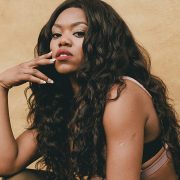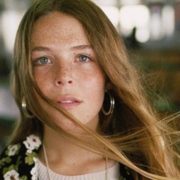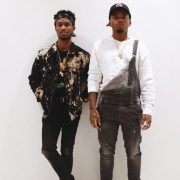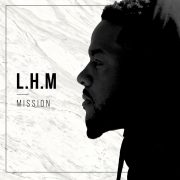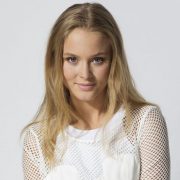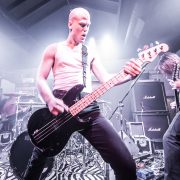THE REBIRTH OF LADY LESHURR
By Alex Macpherson, FADER
Around six years ago, Melesha O’Garro got a job that most wouldn’t expect of a woman who stands at just over five feet in her Nike Jordans. “People always laugh, but you know why I did it?” she says, wide-eyed while sipping pineapple juice in London’s Soho. “Someone in my college was like, ‘you can’t do that, you’re a girl.’ But I’m too stubborn and I love to prove people wrong.”
The artist better known as Lady Leshurr isn’t talking about her rapping career, but the £14-per-hour security job for which she was stationed on the gates of music festivals and football stadiums at the age of 20. During her year as a bouncer, she learned that her stature—a perceived weakness—could be her strongest weapon. “I was so small, no one really wanted to mess with me,” she laughs. “All these men, they use their bigness to their advantage, but they create the problem. I was very bubbly and I’d make people laugh instead—I knew how to defuse the situation.”
The 26-year-old’s approach to her MCing is remarkably similar. Since quitting her security job in ‘09, Leshurr has released nine mixtapes drawing from genres like U.K. hip-hop, grime, garage, and more—tied together with lyrics that juggle metaphors with the kind of quick wit that might lead those in her hometown of Birmingham in the middle of the U.K. to call her a “fibbertigibbet” (an affectionate term for a chattering, chirpy individual). I don’t see how you can hate on a little girl—I look 12 years old!, she giggled on her 2011 remix of Chris Brown’s “Look At Me Now,” before proceeding to demolish the beat with double and triple-time verses honed on the frenetic rhythms of drum’n’bass. She gained a loyal following among hip-hop heads, but it’s this year that U.K. rap’s best-kept secret has caused ripples worldwide.
Over the summer, Lady Leshurr’s video for her freestyle “Queen’s Speech 4” went viral. Shot in one take, the clip shows Leshurr skipping, striding, and spinning down a Birmingham main road, insouciantly dodging cars and acting out the track’s indelible brush your teeth, brush your teeth hook with brightly-colored toothbrushes. With her tutting, taunting, and smirking performance, Leshurr seems to align with a streak of playfulness that’s been prominent in U.K. hip-hop this year, where ebullient breakout tracks like J Hus’ “Lean & Bop” and Krept & Konan’s “Freak of the Week” have made a counterpoint to some of road rap or grime’s more hard-hitting moments.
“Queen’s Speech 4” may take its name from England’s reigning monarch, but it’s not just a U.K. audience that has driven its video to 40 million views on Facebook. Leshurr’s had the song licensed for use in a huge Samsung advert, with its predecessor “Queen’s Speech 3” soundtracking Alexander Wang’s SS16 show, and her U.S. tour this month will include a support slot for Lil Wayne in Seattle. A fifth part in the Queen’s Speech series is coming soon, and Leshurr will also independently release an EP compiling all five installments. With a few inexpensive videos, she has revitalized her career—and it’s all off her own back. “It’s crazy, overwhelming,” she says. “I feel like that’s why no one should ever give up.”
“It’s not just fun and games, I’ve got a story to tell and so much to express, and I don’t want people to think I’m a one-lane rapper who’s talking about funny things all the time.”
Giving up, though, was a real possibility at several points on Leshurr’s journey. Arguably, her breakthrough should have happened in 2012, when that “Look At Me Now” remix found its way onto wildly popular video site World Star Hip-Hop and was a runaway success, essentially going viral in an era when no-one used that word. “Someone posted my number and Atlantic U.S. saw it, called me up, flew me out, asked to see my music, said I was crazy and amazing,” remembers Leshurr. “Then they said: ‘What we’d like you to do first is a diss track to Nicki Minaj. That’ll really solidify you in America.’ My heart and gut instinct were screaming no. I said to them, ‘You have me wrong. You saw me and thought I was a little artist with some buzz and one minute of fame and you’re going to use that.’ I have integrity and I’ve always stuck by that. [The Atlantic A&R] kept writing down more money, more money and pushing it to me. I said, the money’s not going to change how I feel.”
Other labels had come calling in the past; they’d wanted to turn her into a singer or change her image, and she had rejected them as well. “A majority of media, labels, even fans all feel they need to pit female rappers against each other,” reflects Leshurr. “Labels feel the only way they can create a buzz and start someone’s career is off the back of another female. I don’t respect that. It’s not correct. Missy has never had to diss any female rapper to be successful.”
After she turned down Atlantic, Leshurr took nearly two years out of a languishing career to work behind-the-scenes as manager for British MC Paigey Cakey, a one-time regular collaborator and friend. It ended acrimoniously, as Leshurr outlined on last year’s reflective track “Penny Cake”—yet the track is not a diss but a calm explanation, in which Leshurr emphasizes her former ally’s talent and wishes her the best. She describes her time away from music as “a good thinking break,” and one that helped her define the kind of artist she wanted to return as. “I just felt like the scene was missing fun and a sense of humor,” she says. “That’s how I created the Queen’s Speech series—it’s basically an alter-ego where I banter with relatable quotes. I call it banter battle rap.”
Banter is a loaded word in U.K. culture. Traditionally, it involves making tired, puerile, cruel jokes at everyone else’s expense and getting away with it because, apparently, nothing is ever serious. In linking it to battle rap, though, Leshurr undercuts the self-seriousness of the MC battles which she watches avidly, but refuses to participate in—and the results are as funny as hell. I’ll upload a pic of your dog and sell it on Gumtree—just for the bants, it’s all for the bants, she chirps on “Queen’s Speech 3.”
After being introduced to Twitter by U.K. rapper Mz. Bratt (who now goes by the name Cleo.) five years ago, Leshurr jokes that she spends “probably 22 hours a day” online—”Twitter first, then Facebook, then Snapchat, then Instagram.” Her fascination with trending topics is channeled in her verses, which immortalize internet memes that would have otherwise been forgotten within the hour: her 2015 track “Lukatar” takes its title from a viral clip of U.K. tabloid talk show The Jeremy Kyle Show, and “Queen’s Speech 4” replicates the threat of a schoolgirl bully: Are you gonna go and get your cousin? Her pop culture references aren’t those of glossy celebrities or reality television stars, but the characters from around the neighborhood, or the girls at school you didn’t dare to cross.
It’s pure social media humor, but banter can be a risky fire to play with, and Leshurr was burned earlier this year with a cruel and unthinking line in “Queen’s Speech 4”: I’ll turn a man to a girl like Bruce Jenner. She brings the subject up entirely unprompted today, taking the opportunity to offer an apology. “I know a few transgender people and I ran it by them first to double check that people wouldn’t take it to heart,” she offers. “But it’s a sensitive topic that I didn’t really think through. A lot of people called me transphobic. It was genuinely just meant to be a punchline. I’ve never experienced being transgender and I’ll never know how it feels, so I can’t knock them for being mad at me—but I wouldn’t do that to upset anyone.” It’s rare to hear an artist acknowledging their critics, and even rarer to find one so at ease with being corrected.
In the back of an Uber on the way to London radio station Rinse FM’s studios, where she’s doing an on-air interview later, Leshurr scans the pavements for inspiration to use in her rhymes. She clutches her iPhone at all times, with the Notes app in near-constant use. With no warning, she suddenly leans over and starts videoing me for Snapchat. The sight of my flinching in surprise is the first time she’s properly laughed today. “It’s very hard to make me laugh!” she says. “I banter so much that you have to surpass my banter levels, you have to create a next level of humor. I don’t laugh at basic jokes.” She does laugh at surrealisms and surprises, though: thinking hard about the last thing she found properly funny, she recalls a cat video. “Someone was brushing the cat’s teeth, and when they took the toothbrush out this space noise sounded. It’s hard to explain.”
It’s might be difficult to reconcile with her feisty records, but Leshurr says she was a shy and timid child, the kind who would bite her nails and stare at the floor rather than talk to anyone. Raised in the Birmingham suburb of Solihull, she grew up in a house where music was behind every door, whether it was her mother listening to reggae on the radio, her brother banging out the latest drum’n’bass and garage sounds from his bedroom or her sister’s R&B and hip-hop. Inspired by the wordplay of Eminem’s “My Name Is,” Leshurr decided at the age of 13 that she wanted to be a rapper—and proactively set about making it happen. At government-funded local youth groups, she learned the technical skills of how to record your own music, as well as practicing playing the drums, and, with Missy Elliott as an inspiration, started to produce her own beats. Three years later, she put out her first mixtape, Needle In A Haystack, which she distributed herself in Birmingham city center and at local independent record stores.
At the same time Leshurr was taking acting classes, to which she still attributes her comedic abilities and love of making people laugh. Aged 20, she took a role in a British gang film, 1 Day, filmed in and around her hometown. Alongside a young cast mainly from the local area, she flexed both her acting and rapping chops, playing the film’s lead character Flash’s “baby mother” and MCing in a scene in which she confronts him for his philandering ways. The movie didn’t quite find a national audience, but Leshurr benefitted from the exposure. With her name more out there, she started travelling down to London for appearances on hip-hop radio mainstays like Tim Westwood’s show, and SB.TV.
“If I actually was [the character of my lyrics] everyone would hate me. Bowling around telling people their weave smells like cornbread!”
Reflecting on her early years in the industry, Leshurr admits to not always being so confident about her music. “[I was] a bit self-conscious, a bit aware of what people think of me,” she says today. The live, direct, and ephemeral platform of Snapchat, in fact, was Leshurr’s unlikely salvation. “I realised I was actually funny—and I’m very shy around new people, but whenever I’m on Snapchat I’m myself, like I’m with people I’ve known for years,” she explains. She’s created a cast of characters on the app, acting out vignettes from their lives in five to six Snaps at a time. One of these, a snobbish girl named Sandra, already had a cameo in 2015’s “Lukatar” video, for which Leshurr rapped in an upper-crust accent and donned a blonde wig. More skits in this vein are planned, as well as a potential sketch series involving this gang of misfits. Leshurr has always had ambitions in this vein: a fan of Chris Tucker and Katt Williams, she already includes a comedy-style interlude in her live sets, and at times she seems more stand-up comedian than rapper.
Now she’s riding high on the back of “Queen’s Speech 4,” it’s perhaps no surprise to learn that Atlantic have re-approached Leshurr (along with a few other labels, of course). She won’t be drawn on how she intends to respond, but her pleasure at how the situation’s turned is evident. “The ball’s in my court now,” she says with satisfaction. “Back then, I wasn’t in a position to be calling shots. Now, they can see I have my own machine and my own thing, and they want to buy into it. Creative control wise, that’ll be me 100%.”
While Leshurr is still mulling over the various label possibilities that have presented themselves recently, she says that her debut album, tentatively titled Queen Of The Scene, will be out next year. For it, she intends to get back into production, which she hasn’t hasn’t focused on since her teenage years. As well as another creative outlet, she’s mindful that there’s still a barrier to be broken in terms of female rappers producing their own beats. “I think all I need is my own set-up—the beat machine, the keys and everything—and I’ll be on top of it again, I really do.” she reflects. “It’s not just fun and games, I’ve got a story to tell and so much to express, and I don’t want people to think I’m a one-lane rapper who’s talking about funny things all the time. Life experiences, personal issues, family relationships—they’re things I need to address.” The banter queen is ready to get serious.
Until now, there’s only been the occasional hint of Leshurr’s heartfelt writing, such as with the admission back in the day I couldn’t trust mi daddy on “Queen’s Speech 2.” “I never got on with my father,” Leshurr shrugs. “I’ve never known him that much, and when he was around I never trusted him. [That line] just felt like it needed to be there. I want to tap into that because I know people all around the world who haven’t grown up with their fathers or have been in a violent family, and they don’t all have music to express how they feel.”
Later that day Leshurr arrives at the Rinse FM studios on east London’s Brick Lane for Maya Jama’s Drivetime show. On-air, she’s mostly a serious interviewee who mulls over her answers before responding precisely, following DJ Maya’s humor rather than impose her own. Alongside dropping a hint that she’s recently been in the studio with Timbaland working on forthcoming material (she can’t say any more), Leshurr repeatedly emphasizes that the Leshurr of the Queen’s Speech series is an alter ego, not her in real life. “If I actually was that person, everyone would hate me.” she gasps. “Bowling around telling people their weave smells like cornbread!”
Twenty minutes in, the show’s producer springs the idea of a live freestyle on Leshurr, whose energy is winding down after a full day of meetings and interviews. Briefly, you can see the idea of bailing—understandably—on her face. It’s barely a moment, though, and when Leshurr gathers herself she goes in on the beat hard, pulling herself back to a staccato flow before unleashing her full effervescent torrent. Leshurr, pizza, shisha, she rhymes, words pouring out of her as if she’s been storing them in her head for years.
Her life now couldn’t be more different, but Leshurr’s memories of her former security job are almost all fond ones; it got her into football matches and music festivals she wouldn’t have otherwise been able to afford, and the cash enabled her to move into her own flat and buy the clothes and shoes she wanted. Even now, she says she wouldn’t mind going back to it if her career doesn’t work out. Only one awkward moment sticks out: “At one event I ran into Mz Bratt, and she was like, ‘wow, you work here?’ It was a bit embarrassing—she was there on stage doing what I wanted to do, and I was doing this.” It’s fair to say Leshurr won’t have this problem again. On “Million Views,” her follow up track to “Queen’s Speech 4,” she muses in the tones of someone who still suspects it might all be a dream: I woke up one morning, saw one million views. It isn’t just her YouTube stats she’s talking about: after years of grafting away, Lady Leshurr’s future has finally opened up for her, and she has the world in her sight-line.
This article originally appeared on the FADER.
Source: http://www.thefader.com/2015/12/10/the-rebirth-of-lady-leshurr
Photo: https://www.bbc.co.uk/music/artists/ad0bd7eb-fe4f-44e5-addb-037775f0ea87
Video: www.youtube.com

